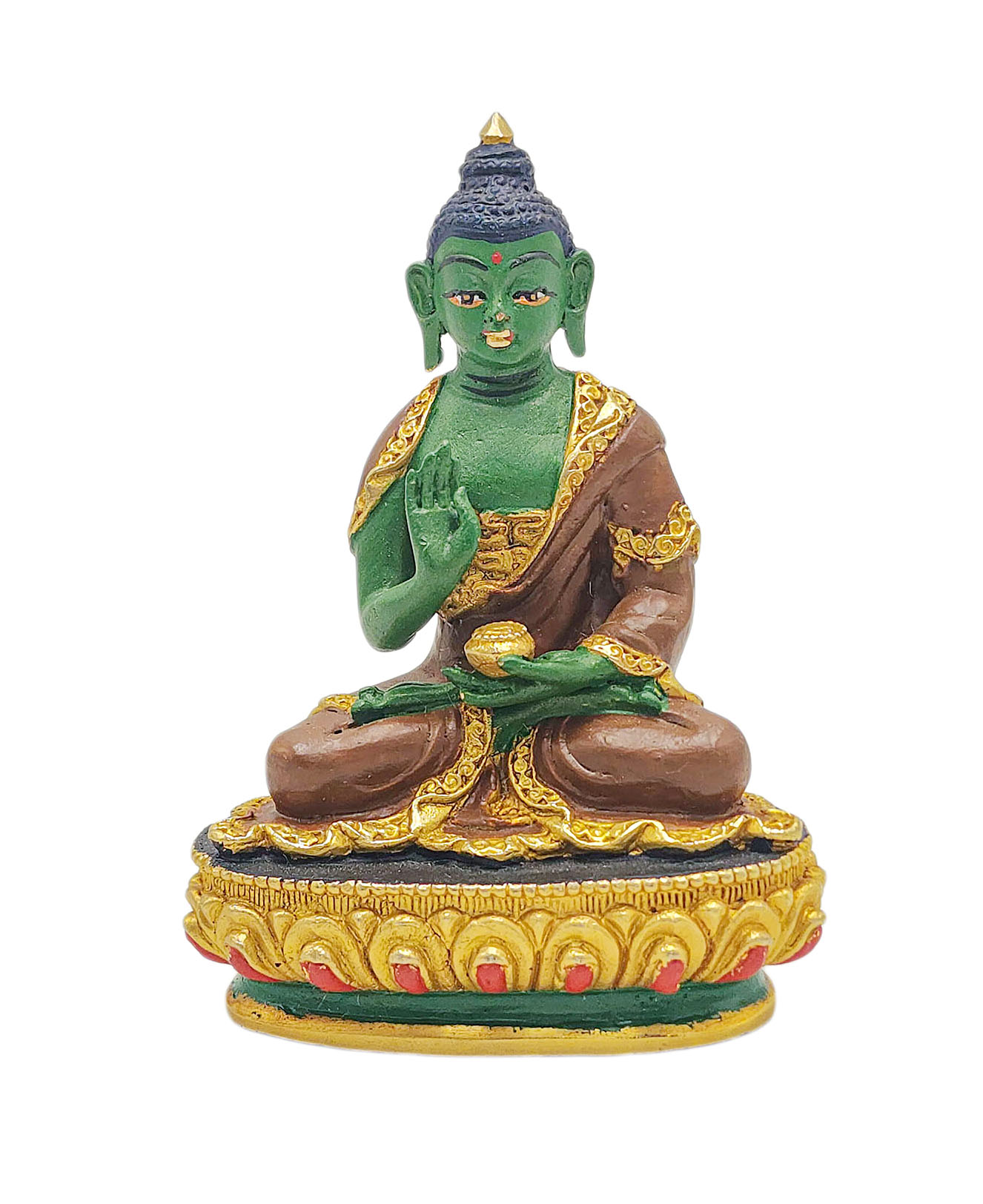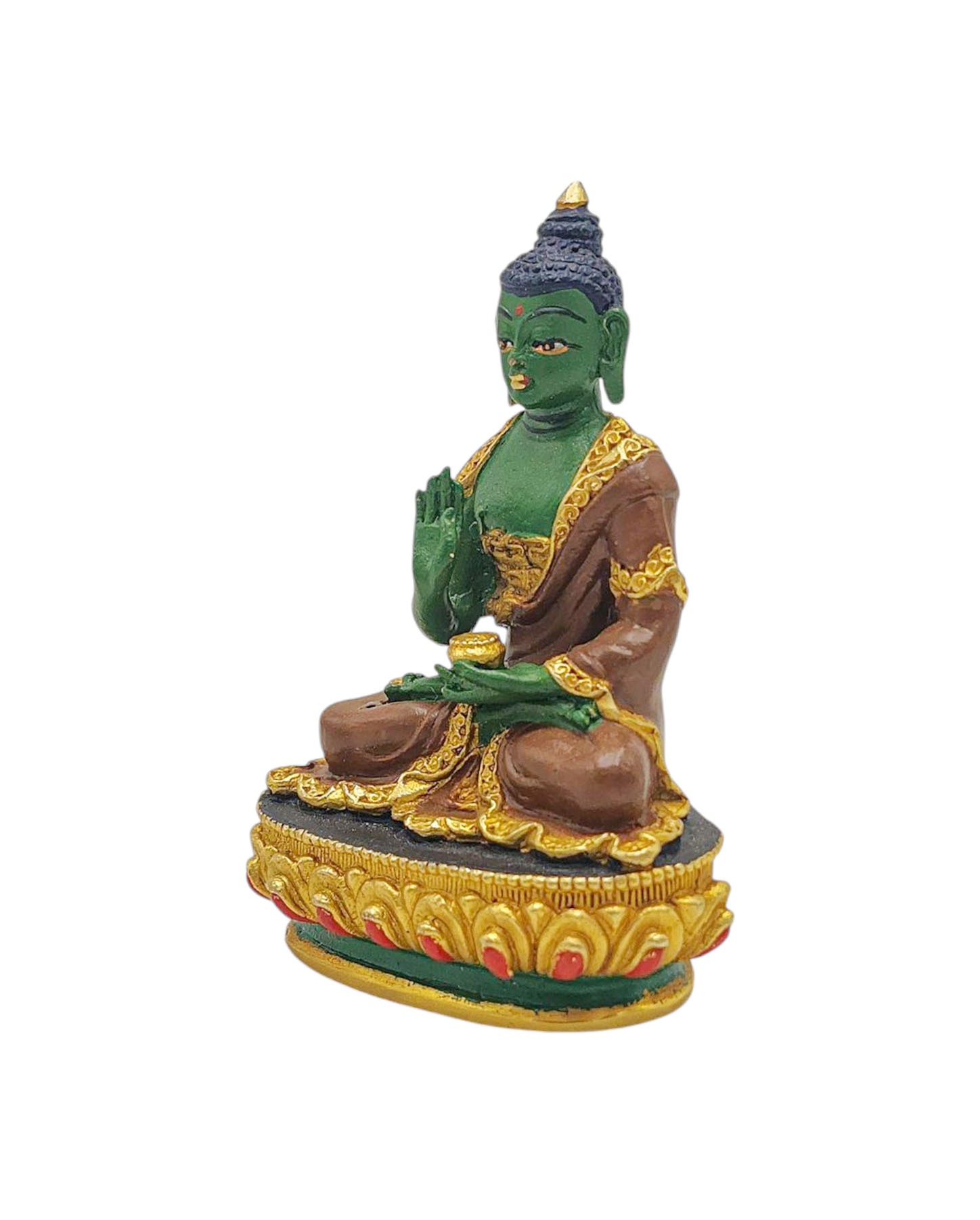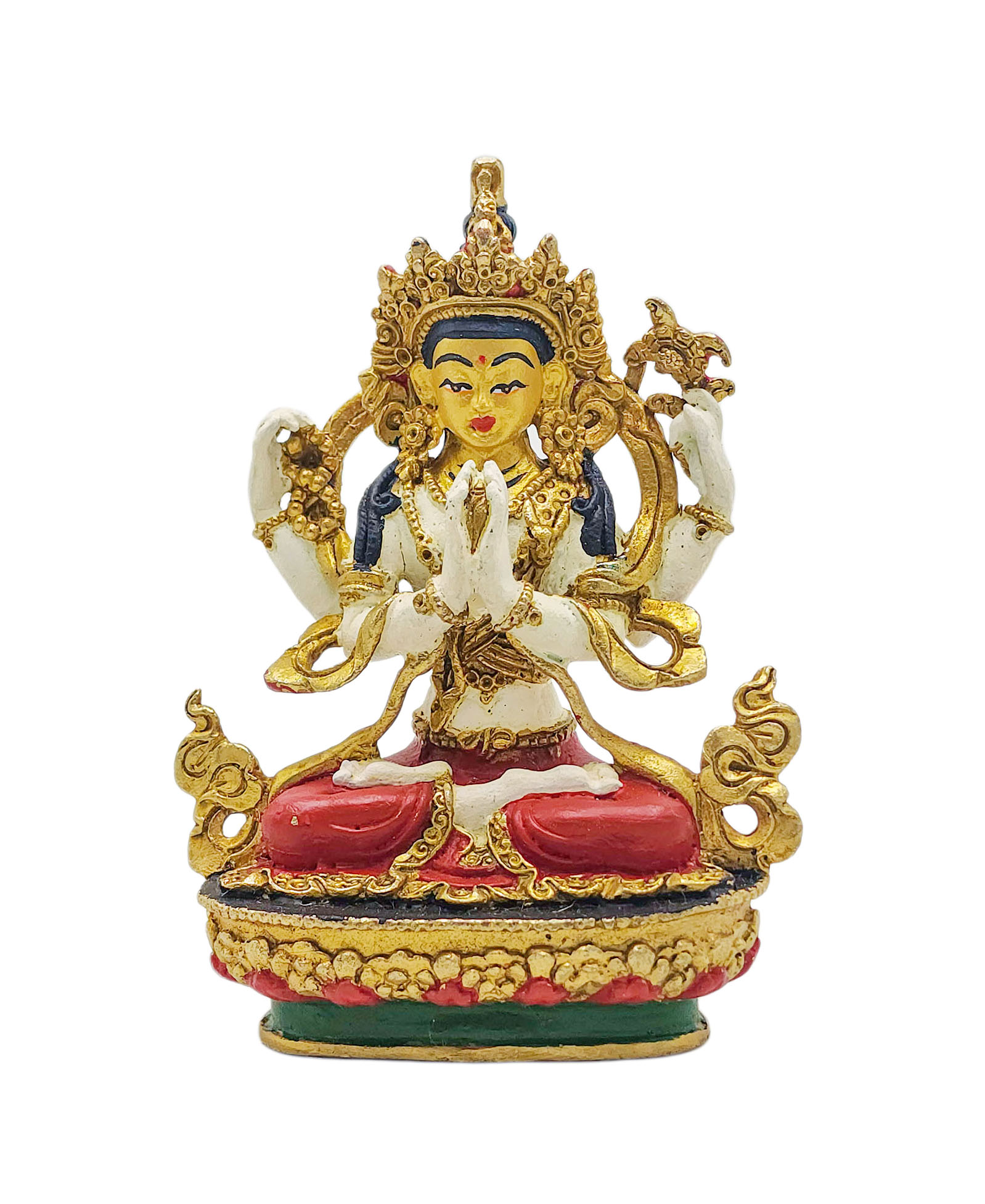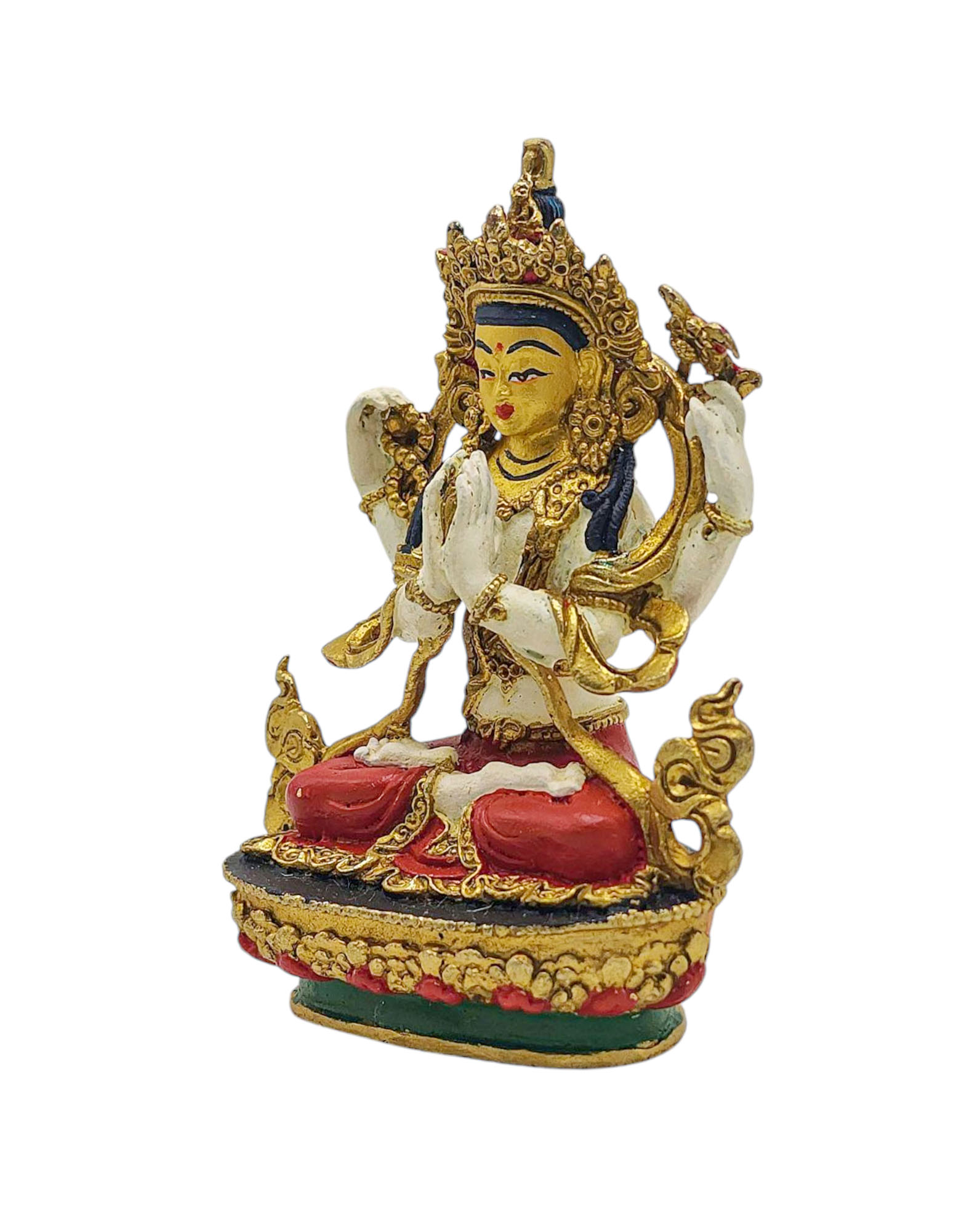Code
HCS35206
Weight
180 gm / 0.4 lbs
Size
Height
8cm (3") Width
6cm (2") Depth
4cm (2") Material
Copper
Availability
Available

Safe Payment
We accept Paypal, Money Transfer, Bank Transfer
Confidence
Protection covers your purchase and personal data.
Worldwide Delivery
We ship Worldwide, except Russia.Shipping cost US$25.2 for upto 0.5 kgs

Hotline
Talk to help line for your question on 9841267335About Color Finishing
The [vairochana Buddha], Buddhist Miniature Statue, [thangka Color Finishing] is adorned with traditional colors, creating a captivating aesthetic through a combination of gold and various hues. This painting technique follows a time-honored process that aims to faithfully represent the [vairochana Buddha], Buddhist Miniature Statue, [thangka Color Finishing] in accordance with traditional color descriptions. In the context of Buddhist statues, this approach holds great significance. Each statue has its own primary color, and it is crucial to depict the statue in its authentic shade. Read More . . .
The [vairochana Buddha], Buddhist Miniature Statue, [thangka Color Finishing] is adorned with traditional colors, creating a captivating aesthetic through a combination of gold and various hues. This painting technique follows a time-honored process that aims to faithfully represent the [vairochana Buddha], Buddhist Miniature Statue, [thangka Color Finishing] in accordance with traditional color descriptions. In the context of Buddhist statues, this approach holds great significance. Each statue has its own primary color, and it is crucial to depict the statue in its authentic shade. Read More . . .
Ceramic Molding System
The [vairochana Buddha], Buddhist Miniature Statue, [thangka Color Finishing] has been crafted using the Ceramic mold casting process, a modern approach that provides an alternative to traditional methods such as the lost-wax system or rubber molding. Also referred to as ceramic molding, this technique involves the creation of a ceramic mold to cast the statue. The process begins by making a precise and detailed wax model of the desired sculpture. The wax model is then coated with layers of ceramic material, creating a sturdy mold. Once the mold is complete, it is fired in a kiln, causing the wax to melt and escape, leaving behind a cavity that perfectly replicates the original sculpture. Molten metal is then poured into the mold, allowing it to fill the cavity and take on the desired form. Once cooled and solidified, the ceramic mold is carefully broken away, revealing the final metal statue. Read More . . .
The [vairochana Buddha], Buddhist Miniature Statue, [thangka Color Finishing] has been crafted using the Ceramic mold casting process, a modern approach that provides an alternative to traditional methods such as the lost-wax system or rubber molding. Also referred to as ceramic molding, this technique involves the creation of a ceramic mold to cast the statue. The process begins by making a precise and detailed wax model of the desired sculpture. The wax model is then coated with layers of ceramic material, creating a sturdy mold. Once the mold is complete, it is fired in a kiln, causing the wax to melt and escape, leaving behind a cavity that perfectly replicates the original sculpture. Molten metal is then poured into the mold, allowing it to fill the cavity and take on the desired form. Once cooled and solidified, the ceramic mold is carefully broken away, revealing the final metal statue. Read More . . .
Brief Description :
Vairochana Buddha, also known as the Great Illuminator, is a central figure in Tibetan Buddhist tradition. As one of the Five Dhyani Buddhas, Vairochana represents the cosmic element of form and embodies the qualities of wisdom, purity, and compassion. Vairochana is believed to be the primordial Buddha, the essence of enlightenment, and the source of all Buddhas. This deity is revered for his ability to guide sentient beings toward awakening and liberation. Devotion to Vairochana Buddha is a significant aspect of Tibetan Buddhist practice.
Iconography:
Vairochana Buddha is often depicted as a radiant white figure, symbolizing his purity and transcendence. He is seated in a meditative posture, with his hands forming the Dharmachakra Mudra, representing the turning of the Wheel of Dharma. Vairochana's peaceful countenance and the crown adorning his head signify his supreme enlightened state.
History:
Vairochana Buddha's origins can be traced back to ancient Indian Buddhist texts and teachings. He gained prominence in Tibet through the propagation of the Vajrayana Buddhist tradition. The concept of Vairochana evolved and integrated with the rich Tibetan Buddhist philosophy, becoming an integral part of their spiritual heritage.
Temples and Monasteries:
While Vairochana Buddha does not have a specific temple dedicated to him in Nepal, there are several monasteries and centers around the world that honor this deity. Some notable places of worship include the Kumbum Monastery in Tibet, Samye Monastery in Tibet, and Shingon Buddhist temples in Japan.
Benefits of Practicing Vairochana:
Devotion and practice of Vairochana Buddha offer numerous benefits to practitioners. By connecting with the wisdom and compassion embodied by Vairochana, individuals can attain clarity of mind, cultivate inner peace, and deepen their understanding of the nature of reality. It is believed that practicing Vairochana's teachings can purify negative karma, heal afflictions, and ultimately lead to enlightenment.
How to Practice:
To practice Vairochana Buddha, one can engage in various methods such as meditation, recitation of mantras, visualization, and studying the teachings associated with this deity. Following the guidance of a qualified spiritual teacher or lama is recommended to gain a comprehensive understanding of the practices and rituals involved.
Mantras of Vairochana Buddha:
The primary mantra associated with Vairochana is:
"Om Vairochana Om"
This mantra can be recited during meditation or as part of a dedicated practice to invoke the blessings and qualities of Vairochana Buddha.
Vairochana Buddha is often depicted as a radiant white figure, symbolizing his purity and transcendence. He is seated in a meditative posture, with his hands forming the Dharmachakra Mudra, representing the turning of the Wheel of Dharma. Vairochana's peaceful countenance and the crown adorning his head signify his supreme enlightened state.
History:
Vairochana Buddha's origins can be traced back to ancient Indian Buddhist texts and teachings. He gained prominence in Tibet through the propagation of the Vajrayana Buddhist tradition. The concept of Vairochana evolved and integrated with the rich Tibetan Buddhist philosophy, becoming an integral part of their spiritual heritage.
Temples and Monasteries:
While Vairochana Buddha does not have a specific temple dedicated to him in Nepal, there are several monasteries and centers around the world that honor this deity. Some notable places of worship include the Kumbum Monastery in Tibet, Samye Monastery in Tibet, and Shingon Buddhist temples in Japan.
Benefits of Practicing Vairochana:
Devotion and practice of Vairochana Buddha offer numerous benefits to practitioners. By connecting with the wisdom and compassion embodied by Vairochana, individuals can attain clarity of mind, cultivate inner peace, and deepen their understanding of the nature of reality. It is believed that practicing Vairochana's teachings can purify negative karma, heal afflictions, and ultimately lead to enlightenment.
How to Practice:
To practice Vairochana Buddha, one can engage in various methods such as meditation, recitation of mantras, visualization, and studying the teachings associated with this deity. Following the guidance of a qualified spiritual teacher or lama is recommended to gain a comprehensive understanding of the practices and rituals involved.
Mantras of Vairochana Buddha:
The primary mantra associated with Vairochana is:
"Om Vairochana Om"
This mantra can be recited during meditation or as part of a dedicated practice to invoke the blessings and qualities of Vairochana Buddha.
Mantra of Viarochana Buddha
namo bhagavate bhai?ajyaguru vaid?ryaprabhar?j?ya tath?gat?ya arhate samyaksambuddh?ya tadyath?: o? bhai?ajye bhai?ajye bhai?ajya-samudgate sv?h?.


![[vairochana Buddha], Buddhist Miniature Statue, [thangka Color Finishing]](https://handmadeexpo.com/pics/product/thumb/35206.jpg)
![[vairochana Buddha], Buddhist Miniature Statue, [thangka Color Finishing]](https://www.handmadeexpo.com/pics/product/thumb/35206_0.jpg)
![[vairochana Buddha], Buddhist Miniature Statue, [thangka Color Finishing]](https://www.handmadeexpo.com/pics/product/thumb/35206_1.jpg)
![[vairochana Buddha], Buddhist Miniature Statue, [thangka Color Finishing]](https://www.handmadeexpo.com/pics/product/thumb/35206_2.jpg)
![[vairochana Buddha], Buddhist Miniature Statue, [thangka Color Finishing]](https://www.handmadeexpo.com/pics/product/thumb/35206_3.jpg)



 of Chenrezig,
of Chenrezig,  of Chenrezig,
of Chenrezig,  Amoghasiddhi Buddha, Buddhist Miniature Statue,
Amoghasiddhi Buddha, Buddhist Miniature Statue,  Amoghasiddhi Buddha, Buddhist Miniature Statue,
Amoghasiddhi Buddha, Buddhist Miniature Statue,  Aparimita, Buddhist Miniature Statue,
Aparimita, Buddhist Miniature Statue,  Aparimita, Buddhist Miniature Statue,
Aparimita, Buddhist Miniature Statue,  Chenrezig, Buddhist Miniature Statue,
Chenrezig, Buddhist Miniature Statue,  Chenrezig, Buddhist Miniature Statue,
Chenrezig, Buddhist Miniature Statue,  Jambhala: Namtose, Buddhist Statue,
Jambhala: Namtose, Buddhist Statue,  Jambhala: Namtose, Buddhist Statue,
Jambhala: Namtose, Buddhist Statue,  Amitabha Buddha, Buddhist Miniature Statue,
Amitabha Buddha, Buddhist Miniature Statue,  Amitabha Buddha, Buddhist Miniature Statue,
Amitabha Buddha, Buddhist Miniature Statue,  with Double Base, Buddhist Miniature Statue
with Double Base, Buddhist Miniature Statue  with Double Base, Buddhist Miniature Statue
with Double Base, Buddhist Miniature Statue  Traditional Color Finishing" title="Vajrakilaya - Dorje Phurba Handmade Statue
Traditional Color Finishing" title="Vajrakilaya - Dorje Phurba Handmade Statue  Traditional Color Finishing" title="Vajrakilaya - Dorje Phurba Handmade Statue
Traditional Color Finishing" title="Vajrakilaya - Dorje Phurba Handmade Statue